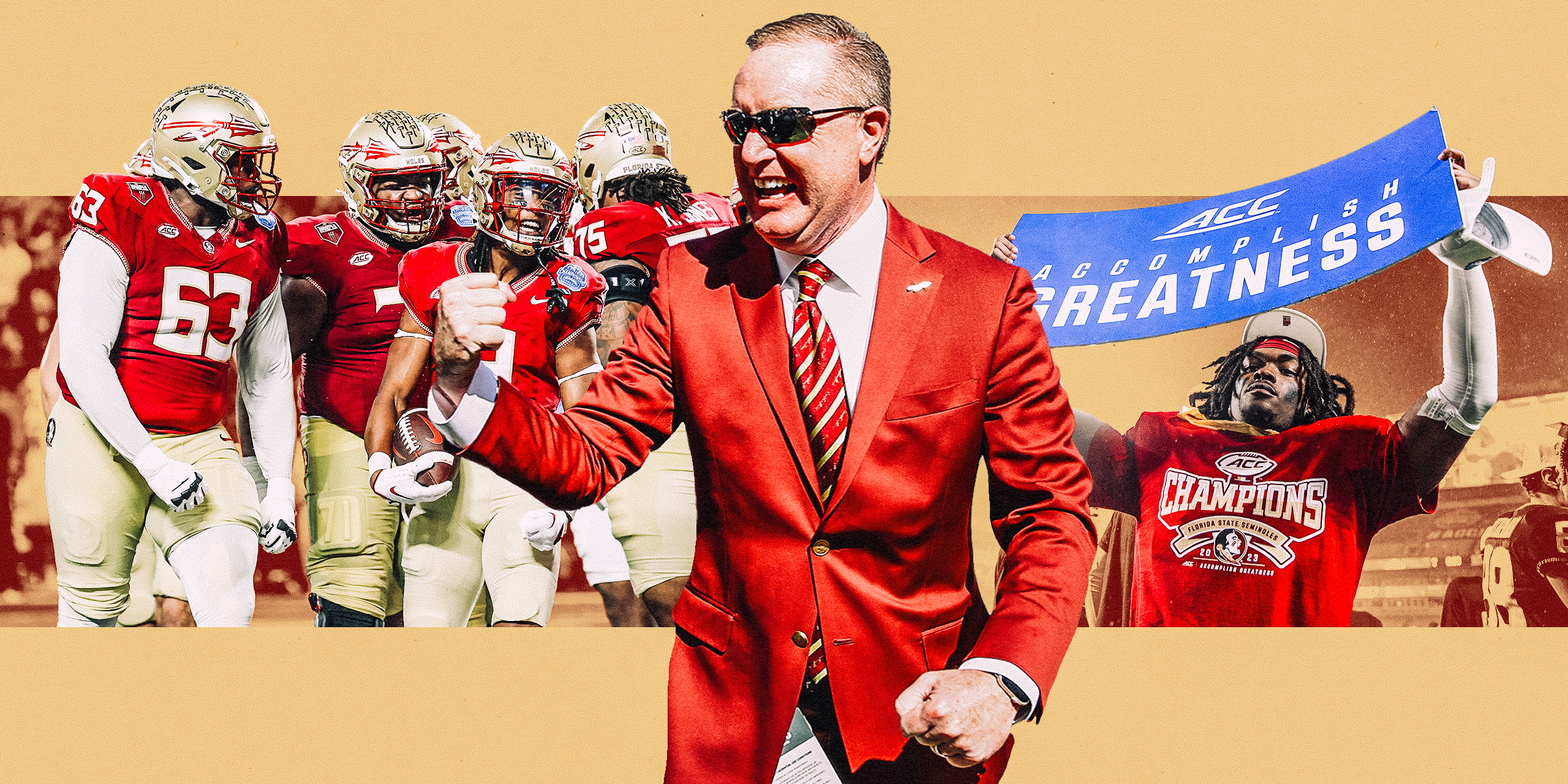
Burnt orange flashed and the University of Texas logo filled the screen, as the Big 12 champion Longhorns locked in the first College Football Playoff berth in program history as the No. 3 seed. Moments later, the red and black of the Georgia Bulldogs appeared next to No. 6, leaving the two-time defending national champions out of the four-team field.
“Florida State or Alabama — one spot,” said Rece Davis, host of ESPN’s selection show. “Whoever is No. 4 plays Michigan. No. 5, heartbroken.
“Who’s No. 4?”
Davis paused as the nation waited to see whether the 13-person selection committee had done what many in college football believed was unthinkable by leaving out an undefeated Power 5 conference champion.
And then the reveal: One-loss Southeastern Conference champion Alabama – not undefeated Atlantic Coast Conference champion Florida State – would compete in the Playoff for a shot at the national championship.
At the watch party in Tallahassee, stunned Seminoles players dropped their heads in disbelief, some covering their faces with towels or hats. Head coach Mike Norvell froze, eyes still trained on the television set, hands shaking. Injured starting quarterback Jordan Travis later wrote that he wished he’d broken his leg sooner, so committee members would realize the Seminoles were still an elite team without him.
“The consequences of giving in to a narrative of the moment are destructive, far-reaching, and permanent,” athletic director Michael Alford said in a statement that day. “Not just for Florida State, but college football as a whole. … It is unforgivable.”
The unprecedented CFP snub ignited the fury of the Florida State fan and donor base and turned everyone’s attention back to the Seminoles’ saber-rattling from the summer. While the tectonic plates of college conference realignment shifted with the expansion of the Big 12 and Big Ten at the expense of the imploding Pac-12, Florida State leaders aired their grievances on the ACC’s approach to revenue distribution and a growing financial gap with its peers in the Big Ten and the SEC, a gap that feeds into perceptions of the ACC’s relative inferiority to the two richest leagues.
“Nationally, the narrative around the ACC is that it’s a weaker, inferior conference compared to the SEC,” said former Florida State star quarterback EJ Manuel, now an analyst for the ACC Network. “They’ve always played second fiddle to the SEC … and I do think that hurt Florida State.”
The late-summer chaos subsided as football season approached, and FSU remained tethered to the ACC. But then the Seminoles were left out of the most important postseason event in college athletics’ most important sport. As Florida State trustee and former quarterback Drew Weatherford noted on X (formerly Twitter) that day, the Big Ten and SEC will have a financial advantage of hundreds of millions of dollars compared to the ACC within 10 years, “and now we are setting a precedent that even a one-loss SEC team is better than an undefeated team from any other conference. This flies in the face of what competition is about.”
Florida State president Rick McCullough, speaking to The Athletic last month prior to the CFP snub, said the Seminoles remain one of the sport’s biggest brands and will need to get creative to keep up financially.
“We need to do whatever it takes to get there,” McCullough said. “We’re behind.”
Florida State’s future is tied to the ACC’s grant of rights, a legally binding document that controls the publicity rights of its member schools and extends throughout the length of the league’s media rights deal with ESPN, which runs through 2036. Either that document keeps the Seminoles in the ACC for nearly 13 more years or they figure out an expensive way to get out, almost assuredly involving a legal fight.
An ACC exit — by FSU or any other disgruntled conference member — would serve as another destabilizing event across the college athletics landscape, on par with the implosion of the Pac-12 or the departures of Texas and Oklahoma to the SEC. The Seminoles remain a realignment wild card, the squeaky wheel in a league that believes its membership is locked into place for more than a decade to come.
Florida State’s CFP exclusion now hangs over ongoing conversations among school officials about how to change or improve their conference situation. And it will likely expedite Florida State’s decision timeline for potential action, multiple sources briefed on such conversations told The Athletic.
All that tension boils down to two questions: What is Florida State’s place in college athletics? And where should the Seminoles be five or 10 years from now?

Florida State celebrated an ACC title in Charlotte, then learned a little over 12 hours later that they hadn’t played well enough to earn a CFP spot. (Bob Donnan / USA Today)
When Alford took over as Florida State’s athletic director in December 2021, he first wanted to fix the alignment between university leadership, athletics leadership, the head football coach and the program’s biggest boosters. His previous role as CEO and president of Seminole Boosters, Inc., the athletic department’s fundraising arm, left him well-equipped to unite the separate factions. That meant communicating better and looping different department leaders into processes they weren’t part of before. Norvell gets to give feedback on facilities projects; McCullough pops in to say hi on recruiting visits and, once, to watch the film of a prospect. These relationships allow the leaders to not just better address the present but plan for the future.
“You’ve got to make long-term decisions,” Alford said. “To have this thing find sustainable success, you have to make decisions now that won’t come into impact for four or five years from now. … You have to believe in your processes and what you do and your experiences where you’ve had success previously, knowing what it looks like and knowing what you have to do to get the program back where it should be.”
For Florida State to be where it believed it should be, it needed to spend money – and lots of it. Alford said the ACC commissioned a study looking at various ways its league members invested in football from 2012 to 2022. The Seminoles ranked last by percentage growth in football operational expenses. Their budget itself was high, but the Seminoles weren’t adjusting it each year to address new needs like their peers were.
So Florida State beefed up its staffing, adding 14 positions that ranged from recruiting personnel to off-field analysts “because that’s where the game was going,” Alford said. He also found that the Seminoles weren’t paying assistants and coordinators on the level of the nation’s elite programs; Florida State’s total salary commitment now ranks among the top 15. Norvell’s $7.3 million annual salary ranks 15th among public schools, according to the USA Today Sports coaching salary database.
And then there were the facilities. Out of the ACC’s 14 programs, Florida State allocated the smallest total square footage for football-dedicated use. Alford went to work, raising money and hiring architects to build out a stand-alone football facility while also planning a $275 million renovation for Doak Campbell Stadium. In 2021, as the seeds of these projects were planted, Alford and Norvell looked at their roster, their upcoming schedules and circled the 2023 season. That could be the special one.
And it is. Well, it was — until that Alabama logo flashed across the screen.
Florida State lost what it believed to be its rightful place in the Playoff to an SEC team, and not just any SEC team but one that had a loss (at home against Texas in Week 2), a win over 6-6 Auburn that required a heroic fourth-and-31 conversion and an ugly 17-3 win over USF.
It is hard, if not impossible, to imagine a similarly situated unbeaten SEC team, even with an injured starting quarterback, being left out of the CFP. Two Florida State sources expressed their belief that if the resumes and injury situations of FSU and Alabama had been flipped, the Crimson Tide would have gotten the benefit of the doubt. Their defense would have received credit for carrying the team in a way that FSU’s did not. Both people brought up Michigan’s offense, which struggled mightily in the final few weeks of the regular season, and how it did not impact the Wolverines’ No. 1 seed whatsoever. It seemed, one said, that Florida State was held to a different standard by the committee compared to any other contending team.
And although those might sound like predictable opinions from the wrong side of a tight CFP race, storytelling is important in college football. SEC commissioner Greg Sankey went on ESPN’s “College GameDay” (which broadcasted live from the SEC title game in Atlanta) on the Saturday morning of conference championship weekend to promote his league, urging the selection committee to include one or more SEC teams regardless of the outcome of that afternoon’s Georgia-Alabama game because SEC teams were not like their peers in other conferences. They were better.
ACC commissioner Jim Phillips was not nearly as visible in the lead-up to Selection Sunday, which rankled Florida State officials who felt that they were the only ones sticking up for themselves, the two sources said. An ACC source pushed back, pointing out that there are more ways to advocate for a team than just in public settings.
After the snub, Phillips went scorched-earth.
“It’s unfathomable that Florida State, an undefeated Power 5 conference champion, was left out of the College Football Playoff,” Phillips said in a statement. “Their exclusion calls into question the selection process and whether the Committee’s own guidelines were followed, including the significant importance of being an undefeated Power 5 conference champion. My heart breaks for the talented FSU student-athletes and coaches and their passionate and loyal fans. Florida State deserved better. College football deserved better.”
Would this have happened if Florida State were in the SEC or the Big Ten? No one can say for sure, and one selection committee member pushed back on the assertion, stating that conference affiliation is not part of the protocol. But those two are the only leagues that have ever sent multiple teams to the same four-team CFP. They often have more teams ranked in the Top 25 than their peers, and strength of schedule metrics typically favor them over teams in other leagues. Every team ranked in the selection committee’s final top 12 will be in one of those two leagues next year — except for the Seminoles.
In a letter written in response to a demand for “full transparency” from U.S. senator Rick Scott and other Florida state lawmakers, CFP executive director Bill Hancock reiterated points made by selection committee chair Boo Corrigan in the immediate aftermath of the rankings’ release, namely that Florida State was ranked fifth because of the injury to Travis and because the Seminoles’ strength of schedule was weaker than the teams ranked ahead of them.
“If being undefeated without regard to a team’s strength of schedule was part of our protocol, other universities with undefeated records would have routinely been considered for the Playoff,” Hancock wrote. “There have been eight, counting Florida State, undefeated teams that did not make the Playoff. While this is the first year such a team was from a so-called P5 conference, strength of schedule remains a crucial factor.”
That “so-called P5 conference” phrasing angered Florida State officials as well as fans still smarting after the snub. To them, that line read as though the CFP didn’t think of the ACC as one of the five most powerful leagues in college football. It felt like the committee was comparing Florida State to unbeaten Conference USA champion Liberty, or any of the other six Group of 5 teams that did not make the top four after undefeated campaigns.

Wins over LSU and Florida this season offered encouraging signs that the Seminoles can compete with anyone at the top of the Power 5. (Melina Myers / USA Today)
Florida State believes that it belongs in one of the best and richest conferences. Multiple members of the Seminoles’ Board of Trustees openly discussed potentially leaving the ACC altogether in public forums in early August.
“It’s not a matter of if we leave (the ACC), in my opinion,” Weatherford, the trustee and former FSU quarterback, said at the time. “It’s a matter of how and when we leave. Not everyone may agree with that, but I feel really strongly about it.”
Trustee Justin Roth called for FSU to make and execute an exit plan to get out of the ACC by August 2024.
During those board meetings, McCullough, the Florida State president, cited projections showing that the Seminoles will fall behind their peers in the Big Ten and SEC by as much as $30 million per year by the end of those leagues’ current media deals. He said that the school “will, at some point, have to very seriously consider leaving the ACC unless there is a radical change to the revenue distribution.” New success initiatives from the ACC — agreed upon this spring and later tied to new revenue brought in by the conference’s upcoming addition of Cal, Stanford and SMU — will allocate additional, significant money for athletic departments that achieve football success, particularly by making and advancing in the College Football Playoff. It is something. But it is not as far as FSU administrators have pushed the conference to go, toward true unequal revenue distribution based in large part on brand value.
Looking back on the panic and pressures of the past summer, neither Alford nor McCullough regret the forceful language they used. Alford said he’d made similar points to ACC leadership and his peers at other schools privately at first before publicly asking for more on behalf of Florida State. McCullough said he was “really happy” with the ACC’s new success initiatives and that the money tied to it “could make a difference for sure.” But what he said in August was more about the bigger picture.
“I have a lot of constituents,” McCullough said. “I have alums. I have coaches. I have student-athletes. I have the board. I have the boosters. There are a lot of people that have an opinion about what we should and should not be doing. There are a lot of people in my key stakeholders group that have great concerns about where we’re going to end up 10 years down the line or whatever.
“I was asked to comment, and I’m a straight shooter. I gave my opinion about what I thought needed to be done for us to remain competitive.”
Alford said Florida State is “the brand of this conference” when it comes to TV and viewership, which means it needs to look at the landscape differently. He believes his push — both privately and publicly — propelled the ACC to its eventual landing spot with the success initiatives this spring. Florida State was one of the three schools that voted against the ACC’s westward expansion, a move that served as the catalyst for a new pool of revenue.
“If we don’t ask that question, we’re doing business the same way it’s always been done,” Alford said. “I thought the question needed to be asked to say, ‘Look, we need to figure this out now.’ Otherwise, you wake up one day and you’ll be three years down the road, doing the math, and you’ve fallen way behind.”
Of course, the Seminoles also wish the ACC had incorporated brand value and popularity as part of its revenue-driving factors in the success initiatives. The Florida State Football account on X (formerly Twitter) routinely posted viewership data this fall, pointedly noting how many more fans viewed games involving the Seminoles than those involving anyone else in the ACC. During a visit from a reporter on campus in October, Alford reminded his communications staff to post about the Florida State-Wake Forest game’s viewership, which was tops among ACC games that weekend.
Both the Big Ten and SEC are expanding next summer, with the Big Ten adding USC, UCLA, Oregon and Washington to balloon to 18 members and the SEC welcoming in Oklahoma and Texas to get to 16. Because of the ACC’s grant of rights, industry sources have described schools like FSU, Clemson and UNC as “unavailable” during the latest conference realignment frenzy. And while all three have had lawyers examine the document, none have challenged it to try to get out of the ACC.
The sense of urgency remains high, even as the expanded Playoff comes next fall and assures the ACC of at least one automatic qualifier per year. But based on historical trends, the league won’t scoop up a lot of at-large spots.
“You’ll just have more SEC and more Big Ten schools get in,” Manuel said. “You’ve basically just created more spaces for those teams.”
With those bids comes even more money, the richest getting even richer.
Despite his clamoring for change and perhaps an early exit, Alford said his relationships within the ACC and with Phillips remain “great” and that his peers understand he is pushing for Florida State’s best interests. He said he does not think independence is a “true option” for the Seminoles right now due to scheduling concerns and the media landscape, but he admitted that he considered it briefly.
He remains focused on figuring out how to best position Florida State for the uncertain future of college athletics, an industry fighting in the courts and in the halls of Congress to retain its longstanding structure as well as the tenets of amateurism. The tension between the haves and the have-nots continues to grow, and the more pressing issue for Florida State is how to remain a “have” in a conference that will bring in less money than the SEC and the Big Ten, with some peers who do not want to win big in football at all costs.
“Each institution in the conference has different priorities,” Alford said. “What’s Florida State’s priority? It’s to win championships and compete nationally across the board.”
McCullough said the key is to figure out how to do that through the school’s myriad revenue streams, from fundraising efforts to the distributions from the ACC. The Florida State athletic department has been working with JP Morgan Chase toward exploring the possibility of raising capital through investment from a private equity firm, school sources said, as it examines new ways to bring in additional revenue streams without changing conference affiliation.
There is, of course, that pesky grant of rights. Even if there’s optimism on campuses of the ACC’s most powerful programs that a school can get out from under it, there’s a difference between hoping to do it and actually doing it. Perhaps a group of schools can dissolve it together, but the public revelation this spring of the names of the seven schools involved in conversations about their shared circumstances spooked some. There are also no assurances from the 16-team SEC or the 18-team Big Ten that invitations are waiting. Whatever happens next — conference consolidation, super league, NCAA breakaway — the Seminoles want in at the highest level of college sports.
They do not want to feel as helpless and heartbroken as they did on Selection Sunday, watching as others decided their future for them without their input.
“Florida State is a brand,” McCullough said. “We are promoting that brand and trying to optimize success in every aspect … so that we’re bringing the best brand and product that we can to the market. That’s, really, our goal right now. That makes us very attractive, I think, as somebody that you would want to have in your league, to be in the ACC.”
(Top illustration: John Bradford for The Athletic; Photos: Isaiah Vazquez / Getty Images)



